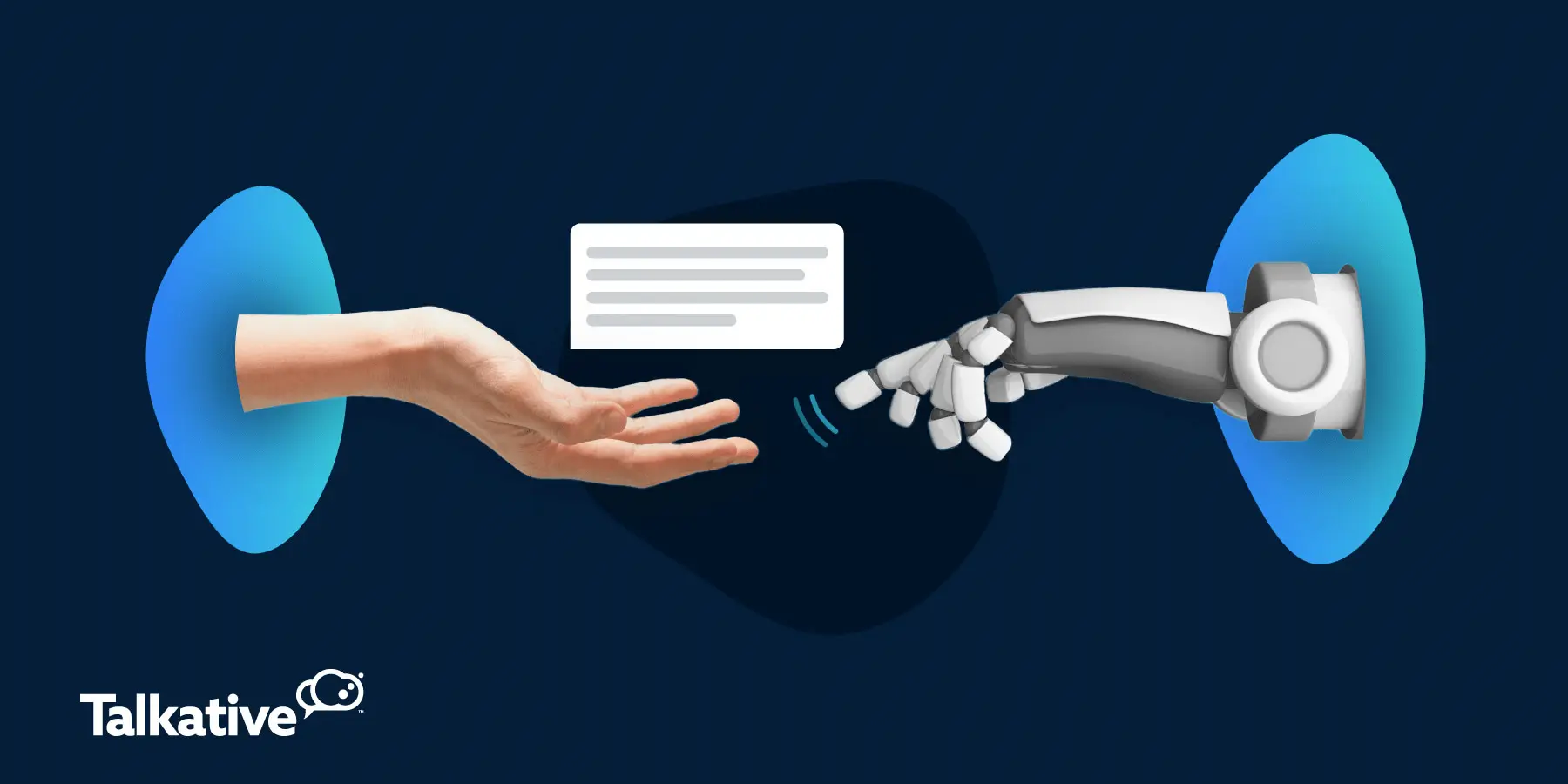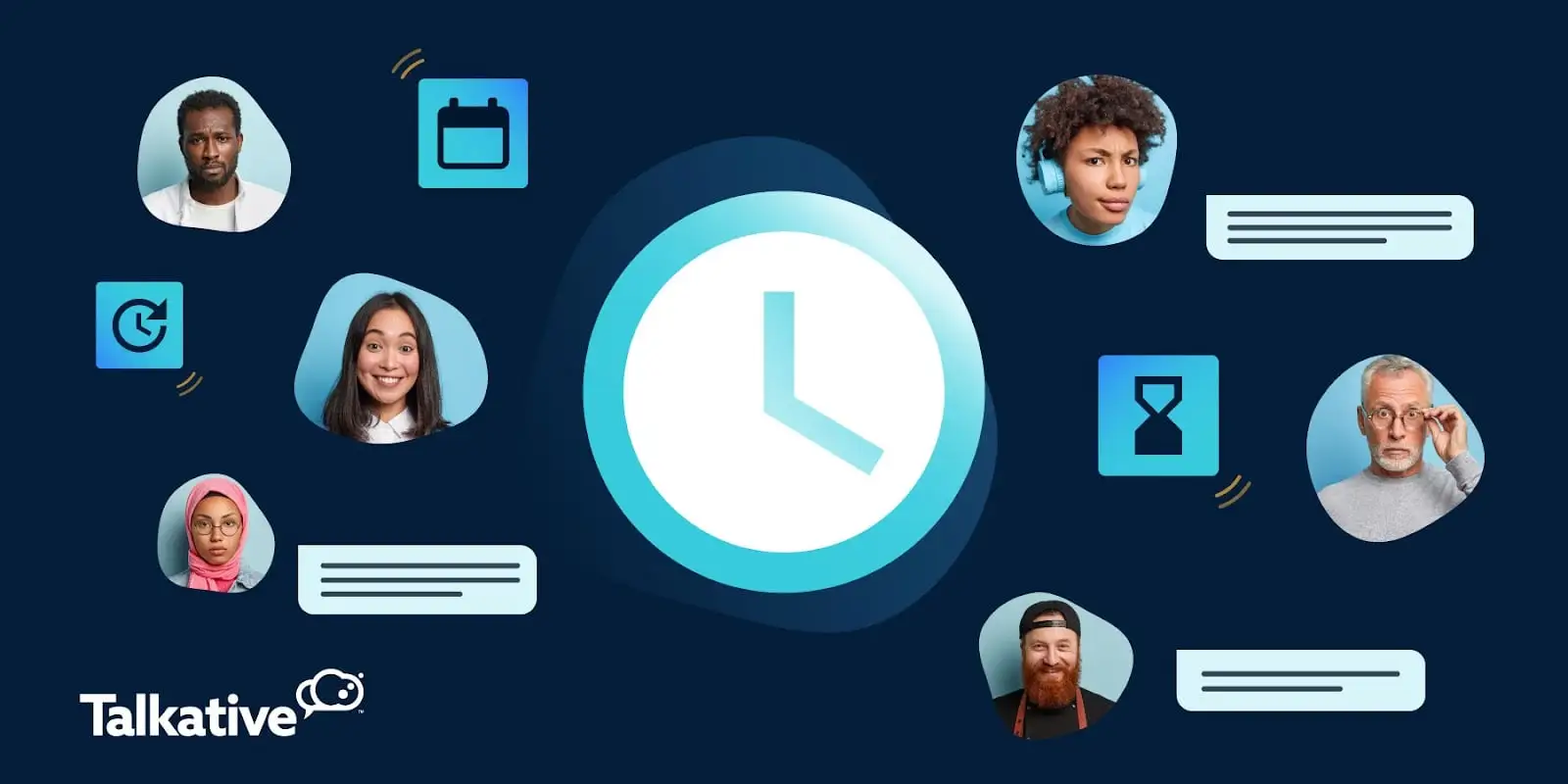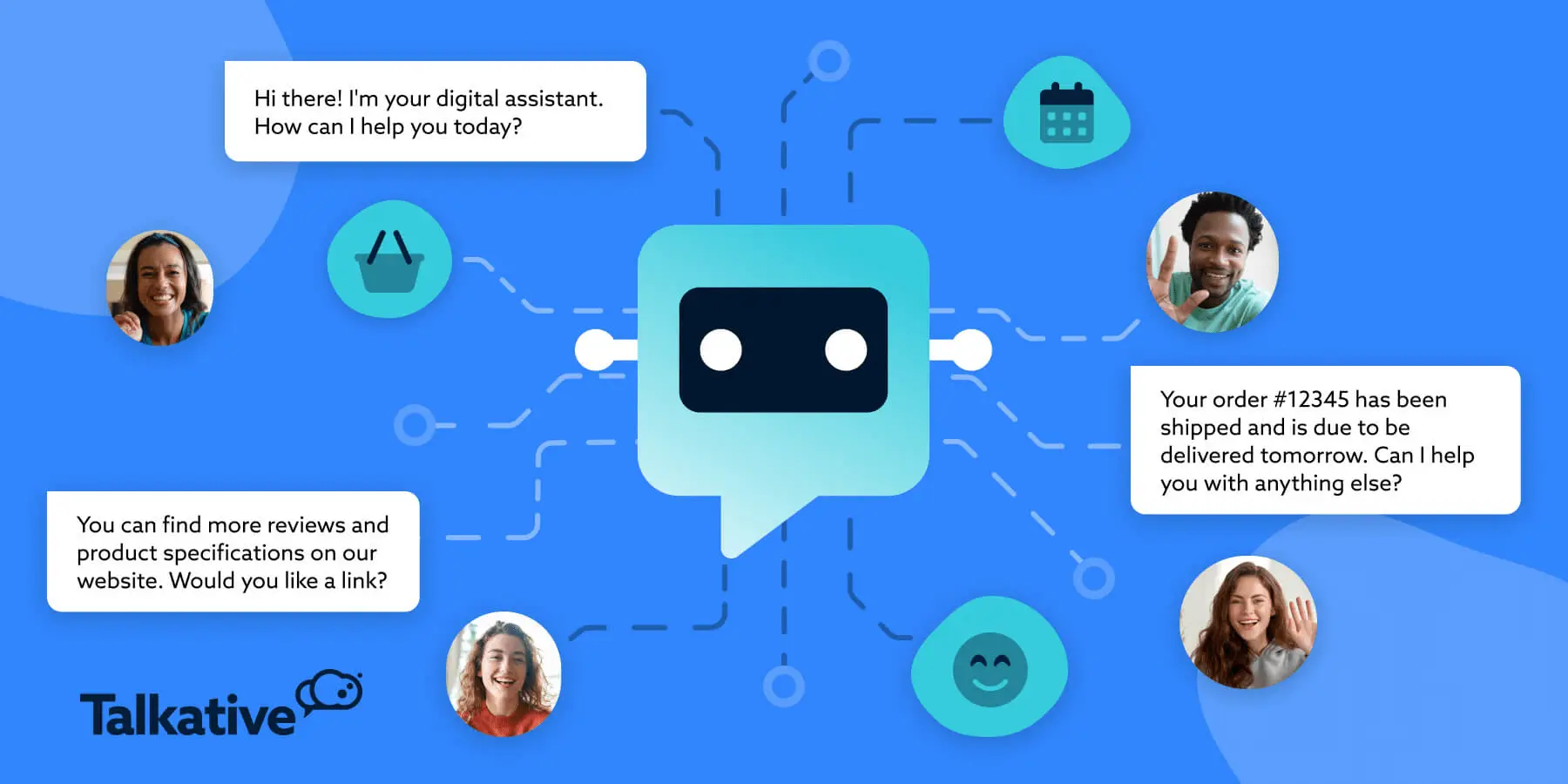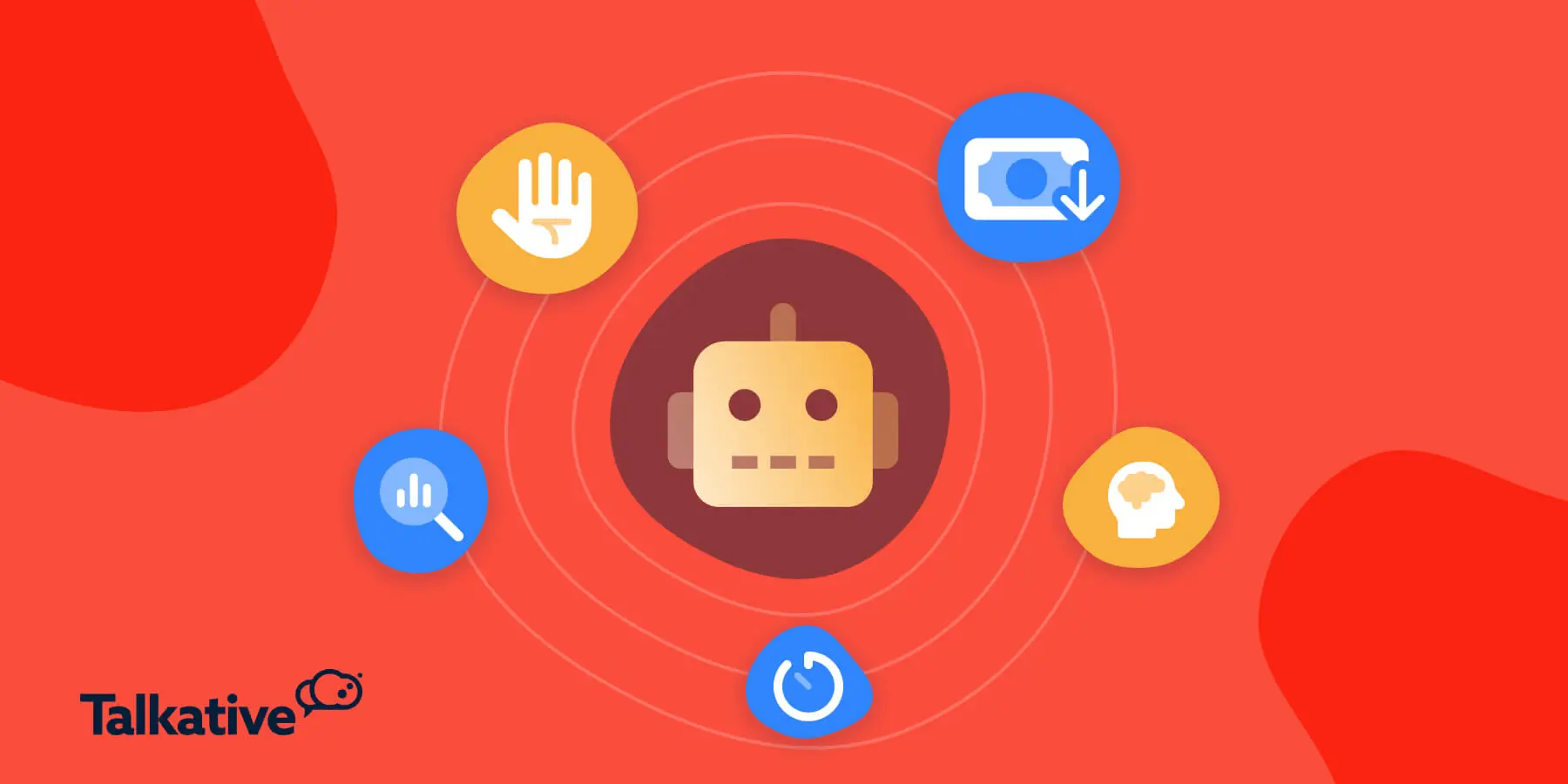The rise of AI in CX has significantly advanced the capabilities of customer service chatbots.
As a result, chatbot usage has skyrocketed by 92% since 2019.
It’s why many leading CRMs now include chatbot functionality - including Salesforce
Salesforce offers a native chatbot solution, Einstein Bots, as part of its platform.
This means that Salesforce users who want to leverage automated support have a choice to make…
Invest in a Salesforce Einstein Bot or integrate with a third-party chatbot provider.
But which option is right for your business needs and customer service goals?
How can you deliver the best chatbot support within your Salesforce environment?
In this guide, we’ll aim to answer these questions for you. We’ll cover:
- An overview of using Einstein bots and other chatbots within Salesforce
- Why use a customer service chatbot in Salesforce?
- How to implement and deliver chatbot support in Salesforce
TL;DR:
In a rush? Here’s our quick tips on how to provide chatbot support in Salesforce...
- Decide what type of chatbot you need: Choose between rule-based, intent-based, AI-powered, or hybrid chatbot models. Evaluate each type’s capabilities against your requirements and customer needs.
- Find the right Salesforce integration: Salesforce Einstein bots aren't optimal, especially when it comes to AI capabilities - research a selection of third-party chatbot providers and evaluate their reputation, feature set, capabilities, customisation options, analytics reporting, data security, cost, and scalability.
- Implement customer service chatbots across key touchpoints: Deploy across your website, app, and messaging platforms (e.g. Facebook Messenger, SMS, WhatsApp) to maximise reach and meet customers where they are.
- Use chatbots alongside human support: Ensure smooth hand-offs to human agents when needed to maintain a positive customer experience. Integrate your bot with other channels for seamless transitions.

Understanding Salesforce chatbots
Salesforce is a leading cloud-based customer relationship management (CRM) system.
It provides a centralised hub to help businesses manage their sales, marketing campaigns, and customer interactions.
One component of the Salesforce platform is Service Cloud Einstein.
Service Cloud Einstein offers a chatbot solution known as Einstein Bots.
This enables Salesforce users to deploy a customer service chatbot across their website and other contact channels.
There’s no doubt that Einstein Bots can be a useful tool for Salesforce customers.
However, they’re certainly not the most cost-effective option - the licensing alone quickly gets very expensive.
This is especially true for businesses with high interaction volumes or more complex needs.
What’s more, Salesforce doesn’t specialise in AI solutions for customer service.
This means that their feature set and customisation options for AI chatbot solutions are limited compared to other providers.
So, if you’re budget-conscious or looking for more advanced AI capabilities...
You’re better off integrating with a Salesforce-approved alternative chatbot provider rather than using Einstein bots.
It’s for this reason that Salesforce developed AppExchange.
AppExchange is a business application store where every featured platform is designed to work natively with Salesforce.
It means you can find and implement a better chatbot solution for your needs - without disrupting your existing Salesforce setup.

Why use a chatbot within Salesforce?
Before we cover how to use a chatbot within Salesforce, let’s explore why you should do so.
Having chatbot functionality in your Salesforce ecosystem can yield significant benefits.
These include...
24/7 availability
Unlike human agents, customer service chatbots don’t need breaks, rest, or days off.
Instead, they can be constantly available to assist customers around the clock.
This is especially useful for global brands with customers based in multiple countries and time zones.

Operational efficiency
Chatbots improve efficiency by automating customer interactions and repetitive tasks.
This reduces agent workloads and lessens the demand on other support channels.
In fact, bots can reduce query volume by up to 70% across voice/video calls, live chat, and email.

Speed
It’s no secret that consumers love fast and efficient service.
Chatbots excel in this area, providing near instantaneous answers and support.
In fact, bots respond to customers three times faster than human agents on average.

Customer self-service
Chatbots are user-friendly and convenient tools for customer self-service.
By answering queries and providing information, bots allow users to resolve issues themselves.
This boosts customer satisfaction and decreases the number of cases requiring human intervention.

Cost savings
Chatbots slash support costs by managing tasks and customer conversations, reducing manual work.
This automation can lead to savings of $23 billion in the U.S.
Additionally, customer service chatbots are a far more cost-effective solution for scalability than hiring additional agents.

Lead generation
Chatbots do more than just automate customer support.
They can also capture and generate leads, resulting in increased sales and conversions.
Case in point, 55% of businesses experience an increase in high-quality leads after deploying a chatbot.

Integration with Salesforce data
By integrating a chatbot with Salesforce, you can leverage the wealth of customer data stored in your CRM system.
This data can include interaction history, preferences, purchase history, and more.
Utilising this information enables your chatbot to provide more accurate and personalised responses.
In summary, customer service chatbots maximise efficiency through automation - helping businesses save time, money, and resources.

How to implement chatbot automation in Salesforce
So far, we’ve covered the basics and benefits of using chatbots in Salesforce.
Now, let’s dive into how to effectively implement and leverage a chatbot - within your Salesforce environment.
Deciding what type of chatbot you need
Choosing the right kind of chatbot for your business is an essential first step.
Different types of chatbots operate in different ways.
How they work depends on the underlying technology, programming, design, and functional purpose.
These factors determine a chatbot’s architecture and the scope of its capabilities.
Figuring out the best chatbot type for your specific needs is essential for long-term success.
To make this decision, it’s important to understand how different chatbots work.
Below is a simplified breakdown of your options…

1. Rule-based (decision tree) chatbots
Rule-based models are the most basic approach to chatbot design.
These bots are programmed with predefined sets of rules and conditions, following a “decision tree” framework.
During interactions, rule-based models identify keywords or phrases in user messages.
These are then evaluated against their pre-set parameters to select the most relevant response.
Rule-based chatbots excel at automating basic and repetitive tasks like answering FAQs.
This is because of their structured design, consistency, and simplicity.
On the flip side, rule-based systems fall short when it comes to flexibility, adaptability, and unforeseen user inputs.
This means that scaling these bots beyond handling routine queries is very challenging.
Rule-based models also lack the technology required to understand and replicate natural human language.
As a result, there’s a risk of providing a frustrating or “bot-like” user experience.

2. Intent-based bots
Intent-based models are the second generation of chatbot technology.
These bots can detect the purpose behind a user’s message and respond accordingly.
They do this using Natural Language Processing (NLP) and intent recognition techniques.
In contrast to rule-based systems, intent-based bots offer some flexibility and scalability.
This is because the NLP technology helps them process human language and varied user inputs.
Despite these improvements, intent-based chatbots still struggle with linguistic nuances.
Additionally, their development often requires technical expertise and a substantial investment of time/effort.

3. AI chatbots
Recent innovations in artificial intelligence have created a new generation of chatbots.
These sophisticated systems are powered by various applications of AI, such as:
- Conversational AI
- Generative AI (genAI)
- Natural Language Processing (NLP)
- Large Language Models (LLMs)
- Machine Learning
AI chatbots excel at analysing huge datasets, processing natural language, and adapting to novel situations.
This makes them far more versatile than their rule/intent-based counterparts.
It means you can scale an AI bot to handle a wide spectrum of tasks and interactions.
AI can also replicate human conversation much more convincingly than rule/intent-based bots.
Although their capabilities are superior, AI-powered chatbots rely heavily on training data.
This means their performance may suffer if the dataset is limited or low-quality.

4. Hybrid chatbots
Hybrid models use a combination of rule-based, intent-based, and AI techniques.
By doing so, these chatbots capitalise on the unique strengths of each approach.
This means that hybrid bots can seamlessly automate both simple and complex workflows.
Hybrid systems typically use pre-established rules/intents for specific functions but also integrate AI technologies.
The incorporation of AI significantly improves their functionality and linguistic capabilities.
For instance, a hybrid bot might use a decision tree framework for FAQs but switch to AI when answering more complicated queries.
This flexible architecture allows you to pick and choose features from all types of bot design.
It means you can blend the simplicity and consistency of rule/intent-based bots with the intelligence and flexibility of AI.
As a result, you’ll get the best of both worlds.
To summarise, all of the above chatbot types have unique strengths and limitations.
Which one is right for you depends on what you want to get out of a Salesforce chatbot.
If you want a versatile virtual assistant capable of advanced automation and a human-like conversational experience...
An AI-powered chatbot or hybrid model is likely the best choice.
That said, you might just want to automate routine queries and somewhat lessen agent workloads.
If that’s the case, a rule or intent-based bot can still be a viable option.
It’s why Talkative’s chatbot solution does both.
With us, you can choose between a rule/intent-based design, AI, or a combined hybrid approach.
This means you’ll have all bases covered with us - whatever your business needs.

Finding the right Salesforce chatbot integration
As we covered earlier, an Einstein Bot isn’t the best solution for every Salesforce user.
For starters, Salesforce’s Einstein Bots are a very expensive option.
This is especially true for small-midsize brands or any budget-conscious business.
Another issue with Einstein Bots is the complexity of implementation and deployment.
The setup process is notoriously challenging, requiring a lot of time and technical expertise.
These factors mean that the best way to get optimal results - in a cost-effective and time-efficient way - is by integrating with a third-party chatbot provider.
Still, finding the right Salesforce integration for your business can be another challenge too.
It’s important to thoroughly research providers before making a decision.
When you’re weighing up your options, keep the below factors in mind…

1. Provider reputation
It’s important to evaluate the reputation of any potential chatbot provider.
Be sure to review any testimonials and customer case studies from other businesses that have used the provider’s services.
Pay particular attention to reviews from brands who utilised the solution via integration.
Ideally, you want a provider who can demonstrate they’ve provided deep and seamless Salesforce integrations to numerous businesses.
A provider with a solid track record and positive feedback is more likely to deliver a reliable and effective chatbot solution.
You should also consider the level of customer support on offer.
A responsive and knowledgeable support team is invaluable during the implementation process - and for ongoing maintenance.

2. Features & capabilities
Different chatbot providers offer various feature-sets and capabilities.
You need to find a solution that supports all the functionalities your business needs.
Some key features/capabilities to consider include:
- Artificial intelligence: If you’re interested in an AI-powered chatbot solution, you should prioritise providers who are committed to innovation and AI advancements. Look for a solution that incorporates conversational AI systems, generative AI, Natural Language Processing (NLP) and/or Large Language Models (LLMs).
- Knowledge base integration: To get optimal bot performance, you need a solution that integrates with your knowledge base. For example, Talkative’s GenAI chatbot allows you to create multiple AI knowledge bases using web pages or file-based resources. The chatbot then learns from this content and can answer countless customer queries.
- Multilingual support: For businesses serving multicultural consumers, having a chatbot that can interact in multiple languages is crucial. It’s why Talkative supports real-time translation into over 100 languages, ensuring an inclusive and seamless experience for all customers.
- Sentiment analysis: Sentiment analysis technology lets you assess customer attitudes towards your bot during interactions. This offers deeper insights into performance and whether your chatbot delivers a positive customer experience.
3. Customisation
More customisation is a key benefit of integrating with a third-party chatbot provider.
Customisation is essential for aligning the chatbot with your brand and business objectives.
It allows you to tailor a chatbot’s design and functionality to meet the specific needs of your customers.
With this in mind, it’s important you have the ability to customise your chatbot's…
- Underlying architecture
- Responses and conversation flows
- Personality
- Dialogue flows
With Talkative, you can achieve this with the help of our user-friendly chatbot builder.
This gives you the freedom and flexibility to create multiple bots tailored to your individual requirements.
You can also leverage our widget editor to fully customise your bot’s chat interface in line with your branding.

4. Analytics reporting
It’s essential that your chatbot provider offers comprehensive analytics tools.
Chatbot analytics are vital for ongoing performance management and identifying areas for improvement.
So, you need a solution that allows you to track and analyse a range of performance metrics.
The key metrics for chatbot performance typically include:
- Number of Interactions
- First-Contact Resolution Rate
- Average Resolution Time
- Average Handling Time
- Escalation (to humans) Rate
- Error/Confusion Rate
- Customer Satisfaction (CSAT) Score
In addition to tracking metrics/analytics, your chosen provider should also offer deeper insights into chatbot performance through reporting.
For example, with Talkative, you can leverage our AI Knowledge Gap Report.
This report generates a full list of all the questions customers have asked your chatbot, plus whether or not the bot could answer them successfully.
Armed with this information, you can identify missing information that can be added to the AI’s training dataset.
This allows you to continuously improve your chatbot’s accuracy, performance, and functionality.

5. Data security
Ensuring security and privacy for your customer data is a top priority.
Users may give personal information during chatbot interactions that must be protected.
Moreover, many providers of AI chatbots integrate their software with other companies (e.g. OpenAI's GPT models) to provide more advanced AI capabilities.
This may be a concern for businesses worried about sharing their interaction data with other parties.
The following should be taken into account when you’re assessing data security and privacy:
- Data protection policies: Look for a provider that has clear policies and controls in place for user data, including how data is stored, who can access it, and how it’s used. Always review the privacy policy of all possible parties.
- Regular software updates: Your chatbot provider should regularly update its software to address security vulnerabilities and ensure that its systems are updated with the latest measures.
- Compliance: Depending on your industry or location, you may need to choose a solution that complies with specific regulations, such as CCPA in the US and GDPR in the European Union.
Fortunately, Talkative has a range of robust data security protocols in place to keep your data safe.
This includes card masking capabilities and PCI compliance for online sales, GDPR and CCPA compliance for data security, and data sovereignty procedures for global brands.
Moreover, the LLMs we integrate with do not store or use customer data.
It means you can rest easy knowing your customer’s privacy is thoroughly protected during chatbot conversations.

6. Cost & scalability
The cost of implementing new technology is always a necessary consideration.
The expense of a Salesforce-compatible chatbot solution will vary based on factors like:
- Chatbot functionality
- Level/depth of integration
- Required feature-set
- Use of AI technologies/capabilities
- Scale of deployment
- Complexity of implementation
You should first decide your budget and then research options that are affordable for you.
It’s important to weigh the initial setup costs against the potential ROI a chatbot could bring.
Try to find a provider that offers tiered pricing plans and flexible payment options, such as monthly or annual subscriptions.
Scalability should also be a deciding factor if you expect your chatbot needs to increase.
In that case, you’ll need the chatbot to handle increasing interaction volumes without compromising performance or user experience.
So, make sure your chosen provider can accommodate this and easily scale up or down to meet your needs.

Implementing chatbot support across key digital touchpoints
Implementing chatbot support on your company website is essential.
But you should also consider deploying a chatbot across various digital touchpoints.
This will make your Salesforce chatbot more convenient and accessible for users.
It also gives customers the flexibility to communicate with you via their preferred platform.
With Talkative, you can deploy a chatbot across multiple key touchpoints, including:
- Your website and app
- Facebook Messenger
- SMS
A multi-touchpoint chatbot strategy maximises reach and ensures customers can always access immediate assistance.
It also means you can meet your customers where they are - at any stage of their digital journey.

Using chatbot automation alongside human support
It's important to remember that chatbots are meant to augment human support, not replace it.
No matter how advanced your chatbot solution is, there will always be some cases where human intervention is required.
In these scenarios, it’s vital that customers can access the help they need.
So, your Salesforce chatbot must be able to initiate smooth hand-offs to human agents.
This includes transferring all relevant context to the agent too, so users don’t have to repeat themselves.
Fail to provide this, and you risk alienating customers.
Your chatbot will likely be avoided due to a frustrating or negative user experience.
Plus, you might even gain a reputation for poor customer service.
Fortunately, with Talkative’s Salesforce integration, you can integrate a chatbot with your other digital communication channels, including:
- Live chat
- Video chat
- Web calling
- Messaging (SMS, WhatsApp, Facebook Messenger)
This enables effortless transitions between channels and a seamless customer experience.
It also ensures there’s a safety net when your chatbot cannot resolve a customer’s query.

The takeaway
Einstein Bots can be a good option for Salesforce users looking to implement chatbot support.
However, they're an expensive option - especially compared to other solutions on the market.
Plus, you’ll gain a wider range of features and capabilities with third-party chatbot technology compared to an Einstein bot.
So, for businesses looking to deliver the best customer experience possible - without breaking the bank - integrating Salesforce with another provider is the optimal choice.
That’s where Talkative comes in.
With our scalable and flexible chatbot solution, you can...
- Choose between an intent/rule-based model, AI, or a combined approach (an AI chatbot with rule-based fall-back for maximum efficiency).
- Integrate our GenAI chatbot with your AI knowledge bases to create virtual assistants that are experts in your brand, products, and services.
- Meet and serve customers across your website, app, and messaging channels.
- Seamlessly escalate to human agents when needed.
- Leverage AI-driven analytics and reporting.
- Build multiple chatbots in house
- Automate customer-specific queries with chatbot fulfilment.
In addition to chatbots, Talkative offers a suite of customer contact channels and capabilities.
These include live chat, web calling, video chat, cobrowse, messaging, AI solutions, and more.
It means you can serve customers across their favourite channels and provide a seamless digital customer experience - all inside your Salesforce environment.
Want to learn more?
Book a demo with Talkative today, and check out our interactive product tour.



